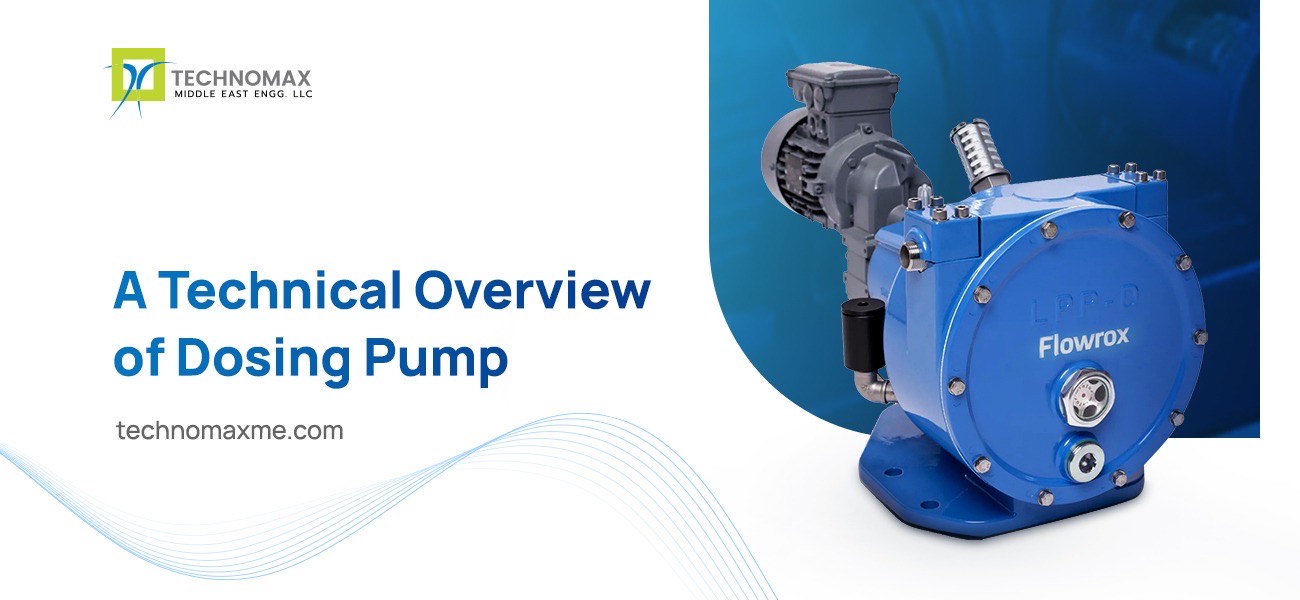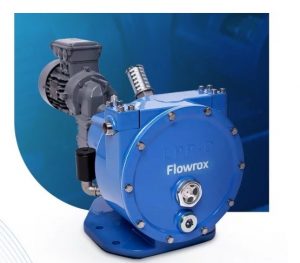
A dosing pump is a positive displacement pump. It's made to add chemicals into water, gas, or steam flow. Dosing pumps, typically compact, offer precise regulation of flow rates.
What is A Dosing Pump?
A Dosing Pump, also known as a Metering Pump or Chemical Feed Pump, is a device used to accurately add specific amounts of chemicals or solutions into a fluid stream, such as water or gas, providing precise control over the dosage for various industrial applications.

If you are looking for Valmet dosing pump in UAE and Middle East?, then Contact Us
Components of a Dosing Pump
A dosing pump consists of several critical components that work together to ensure precise chemical delivery. These include:
- Pump Head: The section of the pump that houses the diaphragm or piston. This is where the suction and discharge of the fluid occur.
- Diaphragm or Piston: Responsible for creating the pumping action. The diaphragm flexes, or the piston moves back and forth, to draw in and push out the chemical.
- Motor or Drive Mechanism: Powers the pump to create motion in the diaphragm or piston. It can be electric, pneumatic, or hydraulically driven.
- Inlet and Outlet Valves: One-way valves that control the flow of chemicals, allowing fluid to enter through the inlet and preventing backflow through the outlet.
- Suction Line: A tube that connects the chemical source to the pump, ensuring a steady supply of the product.
- Discharge Line: Delivers the dosed chemical to the target application or system.
- Stroke Adjustment Mechanism: Allows for control over the pump's output by varying the stroke length or frequency.
- Seals and Gaskets: Prevent leaks and ensure the integrity of the pump during operation.
- Control System: Regulates the pump's operation, which could include timers, flow sensors, or advanced automated controllers for precise dosing.
- Injection Fitting: A device that introduces the chemical into the system or pipeline, ensuring proper mixing with the process fluid.
These components work in harmony to deliver accurate and consistent dosing in industrial, water treatment, or chemical processing applications. Lets analyse how dosing pump works:
How Does A Dosing Pump Work?
Typically powered by either an electric motor or an air actuator, it features a controller responsible for activating the pump, regulating its flow rate, and managing its operation. Certain models may incorporate advanced control systems for enhanced functionality.
Here's a simplified explanation of how they work:
- Suction Phase: The dosing pump draws in the fluid to be dosed from a storage container or reservoir. This is typically achieved through the action of a diaphragm, piston, or rotating gears, depending on the pump type.
- Displacement: Once the fluid is drawn into the pump, it moves through a tube or chamber where the volume is fixed or controlled. This ensures that a consistent amount of fluid is displaced with each stroke or rotation of the pump mechanism.
- Adding Fluid: The displaced fluid is then added to the process stream at the desired point. This addition of fluid can be precisely controlled based on factors such as pump speed, stroke length, or rotation rate, allowing for accurate dosing according to the requirements of the application.
- Control: Dosing pumps may be manually operated or integrated into automated systems for precise control over the dosing process. In automated systems, pumps may be controlled by Programmable Logic Controllers (PLCs), Distributed Control Systems (DCS), or other control devices.
- Adjustability: Many dosing pumps are adjustable, allowing operators to change the dosing rate as needed. This flexibility ensures that dosing can be fine-tuned to accommodate variations in process conditions or requirements.
- Monitoring and Feedback: Some dosing pumps may also incorporate monitoring and feedback mechanisms to ensure accurate dosing. This may include sensors to detect flow rates, pressure, or other parameters, providing feedback to the control system for real-time adjustments if necessary.
Types of Dosing Pumps
Dosing pumps come in various types, each designed to suit different applications and operational requirements. Here's a detailed explanation of some common types:
1. Diaphragm Pumps:
Diaphragm pumps operate by using a flexible diaphragm to displace the fluid. The diaphragm moves back and forth, creating a vacuum on one side and pressure on the other, which draws in and expels the fluid. These pumps are known for their reliability, as the diaphragm isolates the pumped fluid from the pumping mechanism, reducing the risk of contamination or leakage.
Diaphragm pumps are suitable for handling corrosive, abrasive, or viscous fluids and are widely used in water treatment, chemical processing, and pharmaceutical industries.
2. Piston Pumps:
Piston pumps utilise a reciprocating piston to draw in and expel the fluid. The piston moves within a cylinder, alternately creating suction and pressure strokes to pump the fluid. These pumps offer high-pressure capabilities and are suitable for precise dosing applications that require consistent flow rates. Piston pumps are commonly used in applications such as metering chemicals in industrial processes and injecting additives in food production.
3. Peristaltic Pumps:
Peristaltic pumps work by squeezing a flexible tube or hose with rollers or shoes to create a series of occlusions, which propels the fluid through the tube. The fluid being dosed only comes into contact with the tubing, making peristaltic pumps ideal for applications where contamination must be minimised. These pumps are commonly used in laboratory settings, pharmaceutical manufacturing, and food and beverage industries where sterile or hygienic conditions are essential.
4. Rotary Gear Pumps:
Rotary gear pumps consist of two or more intermeshing gears that rotate within a casing. As the gears rotate, they trap and move the fluid from the inlet to the outlet. These pumps offer smooth and continuous flow with minimal pulsation, making them suitable for applications requiring precise dosing.
Rotary gear pumps are commonly used in chemical processing, oil and gas industries, and automotive applications.
5. Solenoid-Driven Pumps:
Solenoid-driven pumps utilise an electromagnetic solenoid to actuate a diaphragm or piston, causing it to move and displace the fluid. These pumps are known for their compact size, simple design, and precise control capabilities, making them suitable for small-scale dosing applications.
Solenoid-driven pumps are often used in medical devices, analytical instruments, and water treatment systems.
6. Lobe Pumps:
Lobe pumps are a type of positive displacement pump that operates using two or more lobes (also known as rotors) rotating within a casing. Each lobe is typically driven by external gears or timing gears, ensuring synchronised rotation. As the lobes rotate, they create a chamber that progressively increases in volume, drawing in fluid from the inlet side of the pump. As the lobes continue to rotate, the chamber decreases in volume, compressing the fluid and forcing it out through the outlet side of the pump.
Each type of dosing pump has its advantages and limitations, and the choice depends on factors such as the nature of the fluid being dosed, required flow rates, pressure considerations, and the level of precision needed for the application.
Dosing pumps are essential tools in various industries, including water treatment, agriculture, pharmaceuticals, and manufacturing. Here are some of the key features and benefits:
Features of Dosing Pumps:
- Precision Dosing: Accurate delivery of fluids or chemicals in precise amounts.
- Control: Ability to adjust flow rates and dosages for specific requirements.
- Simple Control: Easy-to-use interface for straightforward operation.
- Graphic LCD Screen: Intuitive interface with a graphic LCD screen available with content displayed in more than 25 languages.
- Direct Flow Setting: The flow rate can be set directly on the display in ml/h, l/h, or gph for convenience.
- Flexibility: Suitable for any environment or situation, offering versatility in application.
- Turn-Down Ratio: Up to 1:3000/1:1000, reducing the number of models required and enhancing flexibility.
- Flow Control System: Prevents downtime by adapting to variable process parameters such as fluctuations in system pressure.
- Auto Flow Adapt Function: Ensures the dosing process continues with the required flow, even when exposed to external influences.
- Integrated Flow Measurement: Eliminates the need for expensive additional measuring equipment, enhancing cost-effectiveness and convenience.
Benefits of Dosing Pumps:
- Consistency: Ensures consistent and accurate dosing for reliable processes.
- Efficiency: Optimises chemical usage and reduces waste, improving operational efficiency.
- Controlled Processes: Provides control over dosing parameters for enhanced process control.
- Durability: Withstands harsh chemical environments, ensuring longevity and reliability.
- Reduced Downtime: Easy installation and maintenance minimise downtime and associated costs.
- Cost Savings: Long-term savings through reduced chemical consumption and improved efficiency.
- Safety Assurance: Minimises risks of spills, contamination, and worker exposure to hazardous chemicals.
- Flexibility: Adaptable to various applications and operational requirements.
- Sustainability: Supports environmentally friendly practices through reduced waste and optimised resource usage.
- Operational Excellence: Contributes to overall operational excellence by ensuring precise dosing and process optimisation.
Applications of Dosing Pump
Dosing pumps find applications across a wide range of industries due to their precision, versatility, and ability to deliver accurate amounts of fluids or chemicals. Some common applications include:
- Water Treatment: Adding chemicals like chlorine and pH adjusters in water treatment plants for municipal water, swimming pools, and wastewater treatment.
- Chemical Processing: Accurate dosing of chemicals or additives in manufacturing plants to ensure quality and efficiency.
- Agriculture: Injecting fertilisers, pesticides, and herbicides into irrigation systems for crop nutrition and pest control.
- Food and Beverage Industry: Precisely dosing ingredients and flavourings in food and beverage production to maintain consistency.
- Pharmaceutical Manufacturing: Dispensing precise amounts of active pharmaceutical ingredients and other components for drug formulation.
- Industrial Cleaning: Adding cleaning agents and sanitisers to solutions for effective cleaning of equipment and surfaces.
- Mining and Mineral Processing: Injecting chemicals into mineral slurries for separation and recovery processes in mining operations.
- Oil and Gas Industry: Injecting chemicals for corrosion inhibition, scale prevention, and well stimulation in oil and gas production.
- Pulp and Paper Industry: Adding chemicals for bleaching, sizing, and retention in pulp and paper processing to optimise paper quality.
- Medical and Laboratory Settings: Precisely dosing reagents, solutions, and samples in medical treatments, research experiments, and analytical instrumentation.
Valmet Dosing Pump
The Valmet Dosing Pump is a type of pump designed and manufactured by Valmet, a company specialising in process technologies, automation, and services for various industries, including Mining and metal, pulp and paper, energy, and water treatment.
The Valmet Dosing Pump is specifically used for accurate and reliable dosing of chemicals or additives in industrial processes. It is commonly employed in applications where precise control over the addition of chemicals or substances is crucial, such as in water treatment plants, wastewater treatment facilities, pulp and paper manufacturing, and chemical processing industries.
Here is the technical specification table for the dosing pump:
| Specification | Details |
|---|---|
| Series | LPP-D |
| Size Range | 15 - 25 mm / 0.6 - 1 inch |
| Flow Range | 0.1 - 2 m³/h / 3.5 - 71 ft³/h |
| Pressure Range | 7.5 - 16 bar / 109 - 232 psi |
| Temperature Range | 0 - 95 °C / 32 - 203 °F |
Whether you need to dose corrosive chemicals or handle high-viscosity fluids, Valmet Dosing Pumps deliver optimal performance with minimal maintenance requirements. From compact and space-saving models for small-scale operations to high-capacity pumps for large industrial processes, there's a Valmet Dosing Pump to match your needs.
Get your Valmet Dosing Pump from Technomax
Technomax provides Valmet Dosing Pumps that are made to handle the needs of various industries, such as water treatment, chemical processing, and pharmaceuticals.
Moreover, Technomax, a trusted supplier of engineering equipment and services in the Middle East, offers expert support and assistance. Our team of experienced professionals can provide personalised recommendations based on your requirements, ensuring that you get the most suitable solution for your operations.
When you choose a Valmet Dosing Pump from Technomax, you're investing in a reliable and efficient solution that will enhance the performance and productivity of your operations.
FAQ:
1. What is a dosing pump?
A dosing pump is a precision pump used to inject a specific amount of liquid, typically chemicals, into a system at controlled flow rates. It is commonly used in water treatment, chemical processing, and industrial applications.
2. What is the purpose of dosing?
The purpose of dosing is to accurately add a controlled amount of a substance, such as chemicals or additives, into a process to achieve a desired effect. This ensures consistency, safety, and efficiency in various industrial and treatment systems.
3. What chemical is used in a dosing pump?
Dosing pumps can handle a variety of chemicals such as chlorine, acids, alkalis, coagulants, and antiscalants, depending on the application. The specific chemical used depends on the treatment or process requirements.
4. How to calculate dosing pump?
To calculate a dosing pump, determine the required flow rate (liters per hour) and the concentration of the chemical solution needed for the process.
Use the formula: Required Dose (L/hr) = (Volume of system × Desired concentration) / Time.
Learn More About Our Services


Get Started Now!
It takes less than a minute of your time. Or you may simply call +971 2 555 1 783






